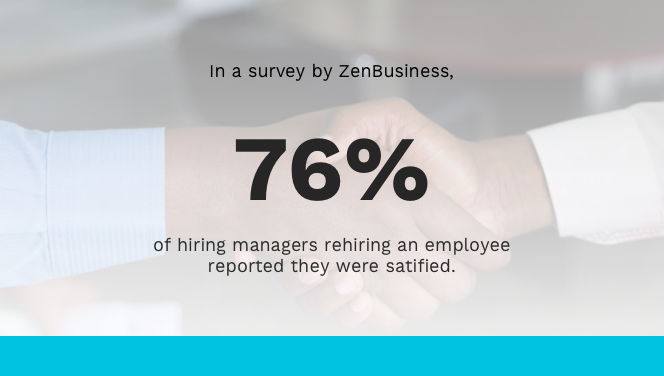It’s never an easy decision to let go of an employee, especially one you think has potential. But as the recent COVID-19 pandemic has shown, sometimes that decision is out of your control.
With businesses around the world forced to close, unemployment increased rapidly. Many companies had to make the financial decision to let some of their employees go.
But now, as businesses start the reopening process, they’ll need to refill some of those positions to get operations up and running again. And undoubtedly, many will be looking to bring their former employees back on board.
Rehiring former employees can be beneficial for your business––even when there isn’t a pandemic going on. Employees who left your company for other opportunities may find themselves returning, or you may want to rehire employees after they’ve gotten additional training or education.
But what should you keep in mind when rehiring a former employee? Here are our biggest dos and don’ts.
What’s in?
- DO look at the benefits
- DO consider limitations
- DON’T skip the interview process
- DO think about the rest of the team
- DON’T forget to set clear expectations
- DO discuss conditions in detail
- DON’T overlook the paperwork
- DO create a customized reboarding program
Like what you see?
Don’t miss out. Subscribe to our quarterly digest to get the latest TA and TM resources delivered right to your inbox.
1. DO look at the benefits
When you bring a new hire on, you need to spend time training and educating them about your business, your processes, and your expectations. Depending on the role, this could take weeks or even months.
But when you’re hiring someone who has already worked for your company, they already know the ins and outs. This means you can spend less time bringing them up to speed.
Hiring a former employee usually includes shorter onboarding periods and lower hiring costs, so your entire team can work more productively faster. Since they’ve already worked at your company, you also know how they fit with the culture.
When you rehire a former employee, you can hit the ground running––especially if they’ve only been away from the company for a few months. You can bring them back on board, give them a quick training refresh, and let them on their way.

Only 9% of small business owners expect not to rehire anyone.
2. DO consider limitations
When you’re looking to fill an open position––especially one that is critical to your team’s overall productivity––you want to get that opening filled as quickly as possible. This may push you to consider a former employee because of the benefits listed above.
However, if that person isn’t the right fit for the role or you believe you can fill the position with a stronger hire, the benefits may not be worth it. If there are limitations that may prevent that individual from doing their best work, they may not be the right hire.
For example, think about your team as a whole. If you’re opening your business back up after the pandemic, you’ll want to look at each role and evaluate if they are absolutely necessary for your reopening. Are there any positions that overlap, or employees who may be able to take on additional roles?
If someone doesn’t fit your new expectations, they may not be the best person to bring on. Before you rehire a former employee back on staff, consider their limitations and their fit for the role, especially if job expectations will change.
You should also consider why the former employee left the company. If it was because of performance issues or a lack of organizational fit, you should think twice before rehiring them.
3. DON’T skip the interview process
If you’re considering hiring back a former employee, going through the interview process can feel redundant. After all, you already know that they’re capable of getting the job done and that they mesh well with the company culture.
But the interview process is a great time to check-in, revisit expectations, and to make sure you’re both on the same page. It also gives you an opportunity to have a conversation with former employees boomerang employees before bringing them back on board.
Think of this interview as a two-way conversation. Evaluate what you’d need out of the employee to make it a good fit, but also see what they might need to feel happy and productive with the company. Come to a mutual agreement about the rehire to ensure you’re both happy with the decision to work together again.
While the interview may not follow the traditional process, you can use this time to discuss the position, what changes might be expected of the employee, and get their feedback. You can then decide if the employee is still the right fit.
4. DO think about the rest of the team
When you’re rehiring a former employee, it also means your current coworkers will regain an old colleague. In many circumstances, this can be a good thing––but in some cases, they might disagree with the move.
Before you bring an old employee back to the team, consider how the rest of your employees might feel. Would they be happy to see their former colleague back on the team, or would they rather have someone new on board?
It’s especially important to consider how direct team members might feel about this decision. If you’re not sure, you can hold one-on-one meetings or discussions to get a better understanding of if they would welcome former coworkers.
Be sure to listen to their hesitations, or why they feel it’d be a good decision. Explain why you want to bring that particular employee back and keep communication open.
5. DON’T forget to set clear expectations
Bringing an old employee back can feel like business as usual, but if you’re not looking for things to go back to the way they’ve always been done, you need to make that clear.
Letting your rehire know what your new expectations are can ensure everyone is on the same page. Laying out the differences between their old position and their new role can prevent confusion and get the job done.
Beyond just telling new employees what you want them to accomplish, establish what KPIs they can use to track their work. Help them identify ways to track those KPIs and achieve their individual goals.
Just like any other new hire, let them know who they should report to or who they can go to if they have questions, concerns, or need help reaching their goals. Don’t assume they know what to do just because they’ve worked there before!

Even though many employees expect to be rehired, it is necessary to have conversations about what you expect from them and vice versa to prevent potential future misunderstandings.
6. DO discuss conditions in detail
One of the things many previous employees expect to stay the same (at least) when they come back on is benefits, salary, and career progression––especially if their leave has been short-term. However, if the company’s circumstances have changed, you need to make that clear.
At this time, many businesses are struggling because of the shutdown. After months of being closed to customers, they’re low on funds and may need to reduce benefits of even salaries. If you’re expecting rehires to come back to work with a pay cut, you need to make that extremely clear from the beginning.
Fill your new team member in on the changes that have happened since they left. Be transparent about any challenges or struggles, and work with them to lay out a plan to get them back on track, including salary, raises, and career growth.
Also, be sure to let them know if their career trajectory may have changed. If you’re expecting team members to take on new responsibilities and roles to close any gaps from restructuring, it might set the former employee along a different path within the company. Make sure these changes are clear and understood before they begin working.
7. DON’T overlook the paperwork
Filling out paperwork is one of the most tedious parts of starting a new job. However, it’s also extremely important––even if that employee has already worked with you in the past.
No matter how much time as passed between when your employee left the company and when you’re looking to rehire, you want to make sure you’re completing all the proper paperwork and legal documents to make the hire official.
For example, if you’re rehiring an employee more than 3 years after they’d completed Form I-9, they might have to complete a new form upon starting again.
(You can learn more about legalities of rehiring after COVID-19-related layoffs here.)
But beyond that, consider what employee and company documents they might need a refresher on. If the employee has only been away from the company for the past couple of months, they might not need a new copy of the employee handbook or culture deck. However, if they’ve been away from the company for a few years, that information has probably changed or they’ve forgotten.
Use this rehiring process to revisit company paperwork and refresh new hires on company policies, needs, and expectations. Taking a look at these documents with fresh eyes can remind them what your business is all about.
8. DO create a customized reboarding program
No matter how much time has passed since they worked with your company, your boomerang employee will need some time to adjust to their role. They’ll need to learn new processes, familiarize themselves with new technology, or just fall back into the grove they had before they left.
Rather than trusting the employee to get where they need to be by themselves, you should create a customized reboarding program that (re)introduces them to all the processes and procedures they need to know. This helps get them up to speed quickly and ensures they’re working productively from day one.
There will almost definitely be parts of the training program that the rehire won’t need––and that’s okay. If they remember how to do something or they already know what steps they should take, they can breeze through it.
To make the reboarding process more effective, talk with the employee about what they feel most comfortable in and what they think they need the most help with. Customizing their reboarding process to meet their unique needs can prevent you from wasting as much time as possible.

Generally, employers as well as employees (74%) view rehiring positively. Effective reboarding helps rebuild the relationship between the boomerang employees, hiring managers, and the team.
Over to you
Rehiring former employees can be a great strategy for ramping up your workforce. But in order for it to work appropriately, you need to be transparent with all stakeholders––including current team members as well as your rehires.
If you’re going to bring past employees back onboard, be sure to communicate your expectations, agree upon employee conditions and benefits, and discuss whatever changes might need to be made before the employee is welcomed back to the team. Putting in these extra steps can go a long way in bringing boomerang employees back on board successfully.


